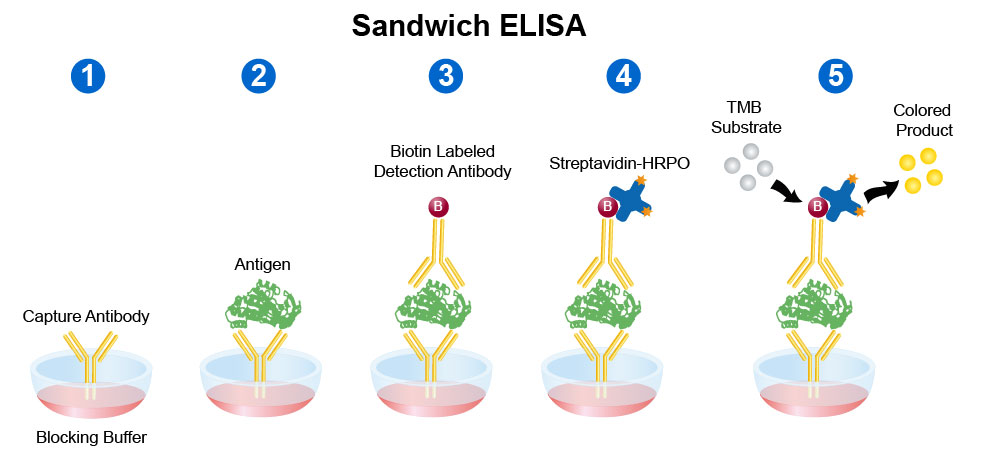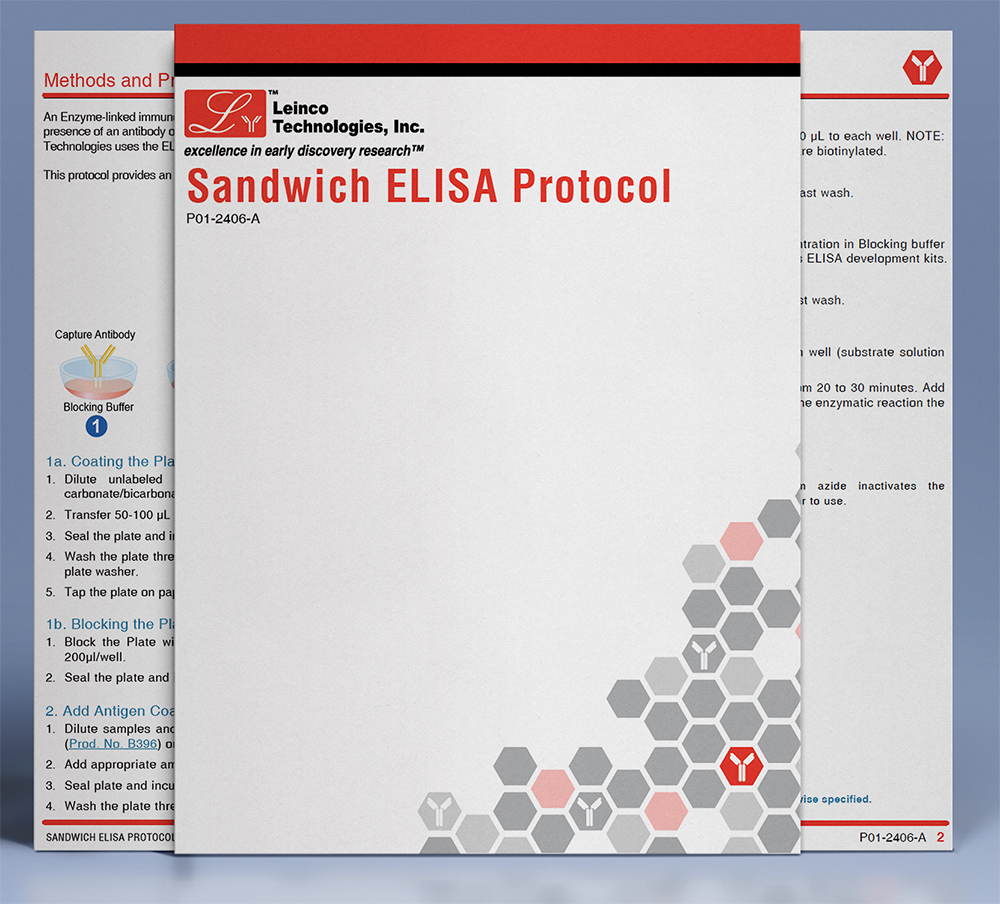Sandwich ELISA Protocol
Methods and Principles from our Scientific Staff
An Enzyme-linked immunosorbent assay or Sandwich ELISA is a scientific technique used by researchers to detect the presence of an antibody or an antigen in a sample. An ELISA can also be used as a diagnostic tool in medicine. Leinco Technologies uses the ELISA as a quality control test to validate our antibodies and proteins.
This protocol provides an initial set of conditions; however, further optimization may be required on an individual basis.

1a. Coating the Plate with Capture Antibody
- Dilute unlabeled capture antibody to a final concentration of 1-10 μg/mL using PBS or carbonate/bicarbonate buffer (pH7.4).
- Transfer 50-100 µL per well to ELISA microplate (Nunc Maxisorp Prod. No. 442404).
- Seal the plate and incubate overnight at 4°C.
- Wash the plate three times with PBS/Tween by using a squirt bottle, multi-channel pipettor or automatic plate washer.
- Tap the plate on paper towels after the last wash to remove residual wash solution.
1b. Blocking the Plate
- Block the Plate with Leinco UltraBlock-FISH Blocking Buffer “Ready to Use”(Prod. No. B396), at 200µl/well.
- Seal the plate and incubate at 37°C for 2 hr or at 4°C overnight.
2. Add Antigen Coating Sample
- Dilute samples and standards to desired concentrations using Leinco Technologies Blocking buffer (Prod. No. B396) or appropriate diluent.
- Add appropriate amount of diluted samples to each well-typically 100µl/well.
- Seal plate and incubate for 1 hr at 37°C or 2 hr at room temperature.
- Wash the plate three times with PBS/Tween and blot on paper towels after last wash.
3. Add the Detection Antibody
- Dilute the detection antibody to 0.25-2 µg/mL in Blocking buffer and add 100 µL to each well. NOTE: All of Leinco Detection antibodies provided in our ELISA Development kits are biotinylated.
- Seal plate and incubate for 1 hr at 37°C or 2 hr at room temperature.
- Wash the plate three times with PBS/Tween and blot on paper towels after last wash.
4. Add UltraAvidin-Horseradish Peroxidase Conjugate
- Dilute the UltraAvidin-HRP conjugate (Prod. No. A106) to its optimal concentration in Blocking buffer (typically 1/500-1/2000). Note: This is provided in all of Leinco Technologies ELISA development kits.
- Add 100 μL per well, seal the plate and incubate for 30 min at RT.
- Wash the plate five times with PBS/Tween and blot on paper towels after last wash.
5. Detection
- Add 100 µL of TMB Microwell Substrate (Prod. No. T118) solution to each well (substrate solution should be at RT prior to use).
- The estimated incubation times for the enzyme-substrate reaction range from 20 to 30 minutes. Add 50 μl of Leinco Technologies stop solution (Prod. No. T125). After stopping the enzymatic reaction the plate should be read at 450 nm.
Solutions
Note: Do not use sodium azide in any buffers or solutions as sodium azide inactivates the horseradish-peroxidase enzyme. All solutions should be at ambient temperature prior to use.
- PBS: Dilute 10 x PBS to 1 x PBS in sterile water.
- Wash Buffer: Prod. No. W101
- Block Buffer: Prod. No. B396
- Diluent: 0.05% Tween-20, 0.1% BSA in PBS*
*Sterile filter and store at 4ºC for up to 1 week.


